inter AUDI A6 2016 Workshop Manual
[x] Cancel search | Manufacturer: AUDI, Model Year: 2016, Model line: A6, Model: AUDI A6 2016Pages: 294, PDF Size: 73.88 MB
Page 155 of 294
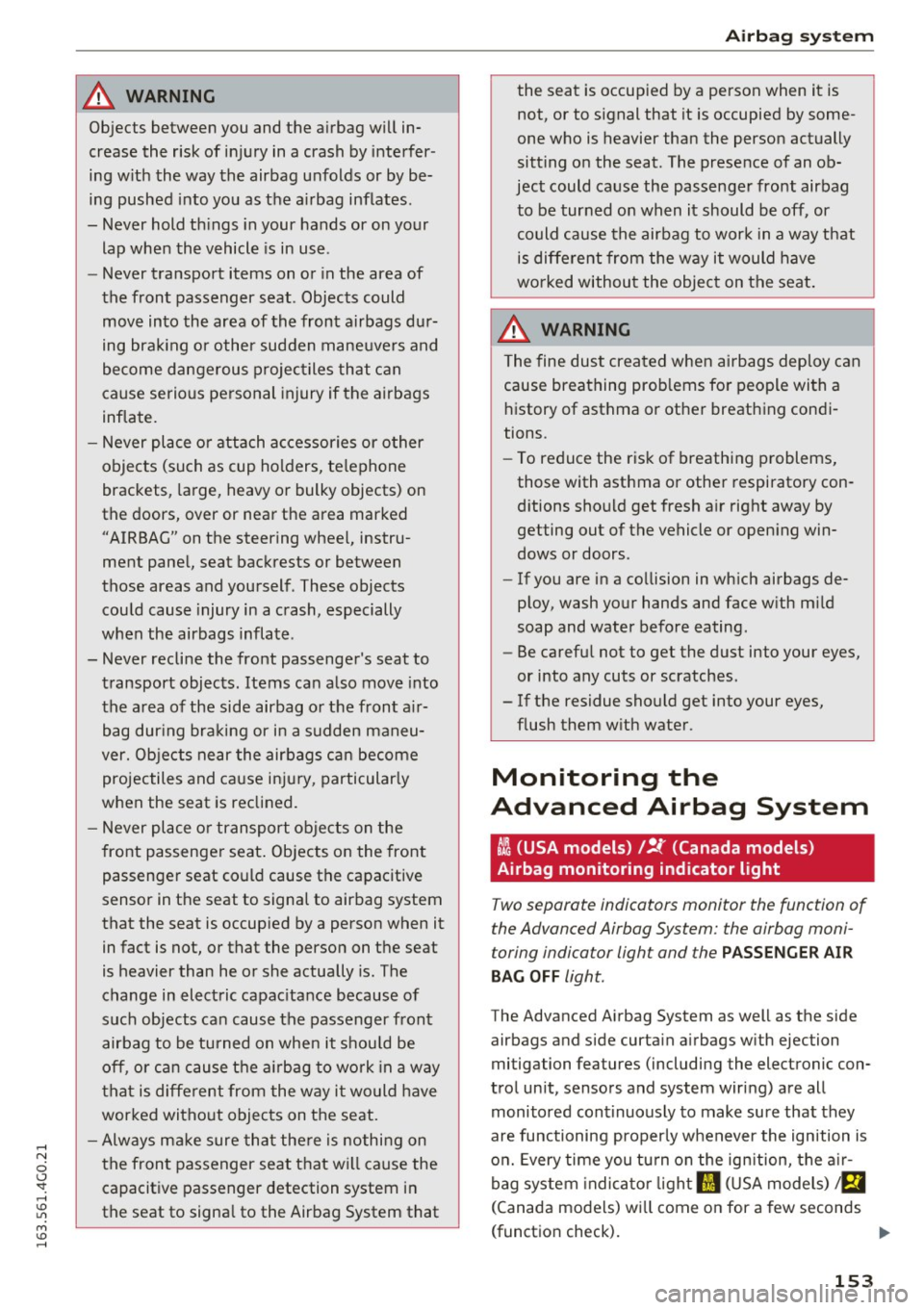
A WARNING 1=-
Objects between you and the airbag will in
crease the risk of injury in a crash by interfer
ing w ith the way the airbag unfolds or by be
ing pushed into you as the a irbag inflates .
- Never hold th ings in your hands or on your
lap when the vehicle is in use .
- Never transport items on or in the area of
the front passenger seat . Objects could
move into the area of the front airbags dur
ing brak ing or other sudden maneuvers and
become dangerous projectiles that can
cause serious personal injury if the airbags
inflate.
- Never place or attach accessories or other
objects (such as cup holders, te lephone
brackets, large, heavy or bulky objects) on
the doors, over or near the area marked "AIRBAG" on the steering wheel, instru
ment pane l, seat backrests or between
those areas and yourself . These objects
could cause injury in a crash, especially
when the airbags inflate .
- Never recline the front passenger 's seat to
transport objects . Items can also move into
the area of the side airbag or the front a ir
bag dur ing bra king or in a sudden maneu
ver. Objects near the airbags can become
projectiles and cause injury, particular ly
when the seat is reclined.
-
- Never place or transport objects on the
front passenger seat . Objects on the front
passenger seat could cause the capacitive
sensor in the seat to signal to airbag system
that the seat is occup ied by a person when it
in fact is not, or that the person on the seat
is heavier than he or she actually is . The
change in electric capac itance because of
such objects can cause the passenger front
airbag to be turned on when it shou ld be
off, or can cause the airbag to work in a way
that is different from the way it would have
worked without objects on the seat.
- Always ma ke sure that there is nothing on
the front passenger seat that wi ll cause the
capacit ive passenger detection system in
the seat to signa l to the Airbag System that
Airb ag sys tem
the seat is occupied by a person when it is
not, or to signal that it is occupied by some
one who is heavier than the person actually
sitt ing on the seat . The presence of an ob
ject could cause the passenger front airbag to be turned on when it should be off , or
could cause the airbag to work in a way that
is different from the way it would have
worked without the object on the seat.
A WARNING
=
The fine dust created when airbags deploy can
cause breathing prob lems for people with a
history of asthma or other breathing condi
tions .
- To reduce the risk of breathing problems,
those with asthma or other respiratory con
ditions should get fresh air right away by
getting out of the vehicle or open ing win
dows or doors.
- If you are in a collision in wh ich airbags de
ploy, wash your hands and face w ith m ild
soap and water before eating .
- Be carefu l not to get the dust into your eyes,
or into any cuts or scratches.
- If the residue should get into your eyes,
flush them w ith water .
Monitoring the
Advanced Airbag System
t!~ (USA models) /!t (Canada models)
Airbag monitoring indicator light
T wo separate indicators monitor the function of
the Advanced Airbag System : the airbag moni
toring indicator light and the
PASSENGER AIR
BAG OFF
light.
The Advanced Airbag System as well as the side
airbags and side curtain airbags with ejection
mitigation fea tures (including the electronic con
trol unit, sensors and system wiring) are all monitored continuously to make sure that they
are functioning properly whenever the ignition is
on. Every time you turn on the ign ition, the a ir
bag system indicato r light
II (USA models) tfll
(Canada models) wi ll come on for a few seconds
(function check).
153
...
Page 159 of 294
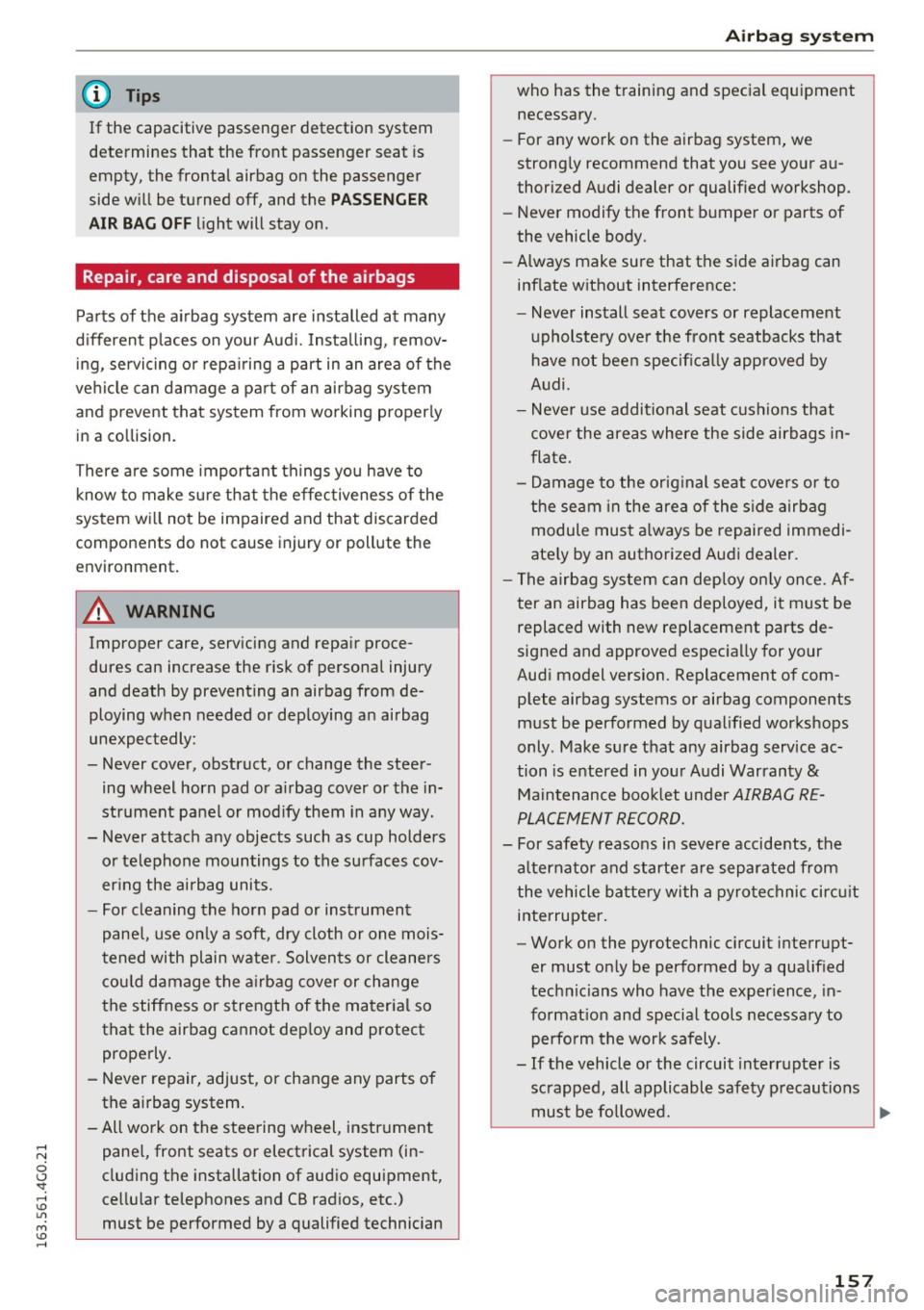
(D Tips
If the capacitive passenger detection system
determines that the front passenger seat is
empty, the frontal airbag on the passenger
side will be turned off, and the
PA SSENGER
A IR BAG OFF
light will stay on.
Repair , care and disposal of the airbags
Parts of the a irbag system are installed at many
d ifferent p laces on your Aud i. Installing, remov
ing, servic ing o r repa iring a part in an area of the
vehicle can damage a part of an airbag system
and p revent that system from working properly
in a co llision.
There are some important things you have to
know to make su re t hat the effectiveness of the
system w ill not be impaired and that discarded
components do not cause injury or pollute the
environment .
A WARNING
Improper care, serv icing and repa ir proce
dures can increase the r isk of personal injury
and death by preventing an airbag from de
ploying when needed or deploying an airbag
unexpectedly:
-
- Never cover, obstruct, or change the steer ing wheel horn pad or a irbag cover or the in
strument panel or mod ify them in any way.
- Never attach any objects such as cup holders or te lephone mountings to the su rfaces cov
er ing the airbag units.
- For cleaning the ho rn pad or instrument
pane l, use on ly a soft, dry cloth or one mois
tened with plain water. Solvents or cleaners cou ld damage the a irbag cover or change
the stiffness or strength of the mater ial so
that the airbag cannot dep loy and protect
properly.
- Never repair, adjust, or change any parts of
the airbag system.
- All work on the steering wheel, instr ument
pane l, front seats or electrical system (in
cluding the installation of audio equipment,
cellu lar telephones and CB rad ios, etc.)
must be performed by a qualified technician
Airb ag sys tem
who has the t raining and spec ial equ ipment
necessary.
- For any wo rk on the airbag system, we
strong ly recommend that you see yo ur au
thorized Audi dealer or qualified workshop.
- Never modify the front b umper or parts of
the vehicle body.
- Always make sure that the side a irbag can
inflate w ithout interference:
- Never ins tall seat covers or replacement
u pholste ry ove r the front seatbacks that
have not been specifica lly approved by
Audi.
- Never use addi tional seat cushions that
cove r the areas where the side airbags in
flate.
- Damage to the orig inal se at cove rs or to
the se am in the area of the s ide airbag
module must a lways be repaired immedi
ate ly by an authorize d Aud i dealer.
- The airb ag system can deploy on ly on ce. Af
ter an airbag has been deployed, it must be
replaced with new replacement parts de
signed and approve d espec ially for your
Aud i model version. Replacement of com
p lete airbag systems or airbag components
m ust be performed by qualified workshops
only . Make sure that any airbag service ac
tion is entered in you r A udi Warranty
&
Maintenance boo klet under AIRBAG R E
PLAC EM ENT R ECORD.
- For safety reasons in severe accidents, the
alternator and starte r are separated from
the vehicle ba tte ry with a pyro te chnic cir cui t
interrupter.
- Work on the pyrotechnic c ircuit interrupt
er must on ly be performed by a qualif ied
technic ians who have the exper ience, in
format ion and specia l tools necessa ry to
perfo rm the wor k safely.
- If the vehicle or the circuit interr upte r is
scrapped, all applicable safety p recautions
must be followed.
157
Page 162 of 294

Airbag syste m
Important safety instructions on the knee
airbag system
A pplies to veh icles: w ith knee a irbags
Airbags are only supplemental restraints. Always
wear safety belts correctly and ride in a proper
seating position.
There is a lot that you and your passengers must
know and do to help the safety be lts and airbags
to provide supplemental protection .
A WARNING
An inflating knee airbag can cause serious in
jury . Wearing safety belts incorrect ly and im
proper seating pos it ions increase the r isk of
serious personal injury and death whenever a
vehicle is being used.
- The knee airbag system cannot protect you
properly if you are seated too close to any of
the airbag locations. When adjusting their
seat positions, it is important that both the dr iver and the front passenger keep their
upper bod ies and knees at the following
min imum safe distances:
- at least 10 inches (25 cm) between the
chest and the steering wheel/instrument
panel.
- at least 4 inches (10 cm) between the
knees and the lower part of the instru
ment panel.
- The risk of personal injury increases if you
lean forward or to the side, or if the seat is
improperly positioned and you are not wear
ing your safety belt. The risk increases even
more should the a irbag deploy.
- Always make sure that the knee airbag can
inflate without interference. Objects be
tween you and the airbag can increase the
risk of injury in an accident by interfer ing
with the way the a irbag dep loys or by being
pushed into you as the airbag deploys.
- Never let anybody, especially children or
animals ride in the footwell in front of the passenger seat . If the a irbag deploys, this
can result in serious or fatal injuries.
- Never carry objects of any k ind in the foot
well area in front of the driver's or pas
senger's seat . Bulky objects (shopping
1 6 0
bags, for example) can interfere with or
prevent proper deployment of the a irbag.
Small objects can be thrown through the
vehicle if the airbag deploys and injure you
or your passengers.
- Make sure there are no cracks, deep scratch
es or other damage in the area of the i nstru
ment panel where the knee airbags are lo
cated .
-If ch ildren are incorrectly seated, their risk
of injury increases in a coll ision
c::;, page 166, Child safety.
Side airbags
Description of side airbags
The airbag system can provide supplemental
protection to properly restrained occupants.
Fig. 162 Side airbag location in the driver"s seat
The side airbags are located in the sides of the
front seat backrests
c::;, fig. 162 and the rear back
rest fac ing the doors . They are identified by the
word "AIRBAG".
The side airbags installed for the front seating
positions have been designed and certified to
help reduce the risk of injury that can be caused
by a irbags when they inflate, particu larly when
the occupant sitting next to it is not seated prop
erly. The side airbag for the front passenger seat can be used with properly installed child re
straints . Please be sure to read the important in
formation and warnings whenever using a child
restraint in a vehicle: Safety belts
c::;, page 134,
Airbag system c::;, page 142, Child safety
c::;, page 166 .
The s ide ai rbag sys tem basica lly c onsi st s of: ..,.
Page 164 of 294
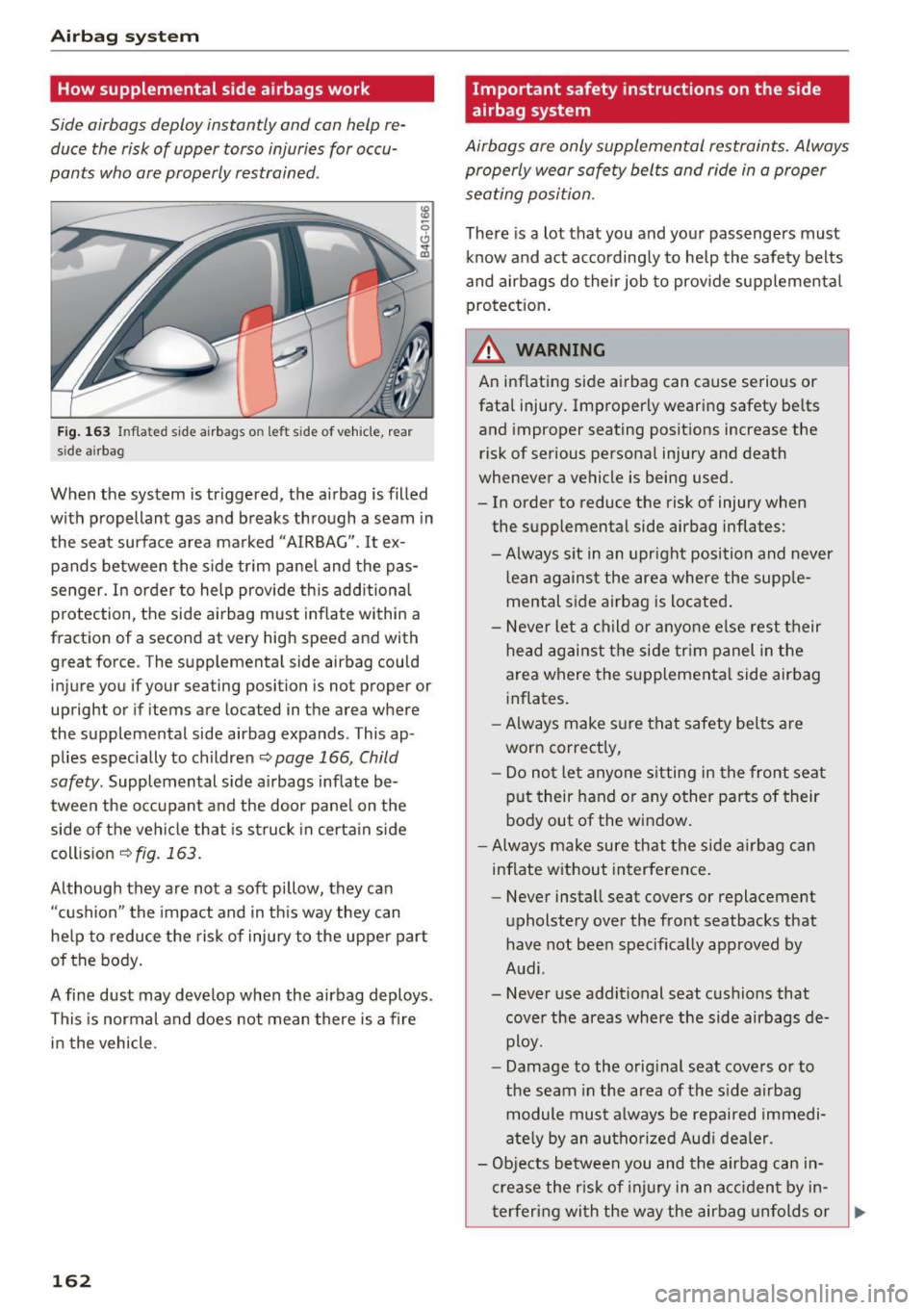
Airbag syste m
How supplemental side airbags work
Side airbags deploy instantly and can help re
duce the risk of upper torso injuries for occu
pants who are properly restrained .
------
Fig . 1 63 In fla ted side airbags o n lef t s ide of vehicle , rear
side a irbag
When the system is triggered, the a irbag is filled
with propellant gas and breaks through a seam in
the seat surface area ma rked "AIRBAG". It ex
pands between the side trim pane l and the pas
senger. In order to help provide th is additiona l
protection, the side ai rbag must inflate within a
fraction of a second at very h igh speed and with
great force . The supplementa l side airbag could
injure you if your seating position is not proper or
upright or if items are located in the area where
the supplemental side airbag expands . This ap
plies especially to children
~ page 166, Child
safety .
Supplemental side a irbags inflate be
tween the occupant and the door pane l on the
side of the vehicle that is struck in certa in side
coll is ion
~ fig. 163.
Although they are not a soft pillow, they can
"cushion" the impact and in th is way they can
help to reduce the risk of injury to the uppe r part
of the body .
A fine dust may develop when the airbag deploys .
This is normal and does not mean there is a fire
in the vehicle .
162
Important safety instructions on the side
airbag system
Airbags are only supplemental restraints . Always
properly wear safety belts and ride in a proper
seating position .
There is a lot that you and your passengers must
k now and act according ly to help the safety belts
and airbags do their job to prov ide supplemental
protect ion .
_& WARNING
An inflating side airbag can cause serious or
fatal injury. Improperly wearing safety be lts
and improper seating posit ions increase the
risk of serious persona l injury and death
whenever a vehicle is being used.
- In order to reduce the risk of injury when
the supplemental side airbag inflates:
- Always s it in an upr ight position and never
l ean agains t the area where the supple
mental s ide airbag is located .
- Never let a child or anyo ne e lse rest their
head against the side tr im panel in the
area where the s upplementa l side airbag
inflates .
- Always make s ure t hat safety belts are
worn correctly,
- Do no t let anyone s itting in the front seat
p ut their hand or any other parts of their
body out of the window.
- Always make sure that the side a irbag can
inflate w ithout interference.
- Never install seat covers or replacement
upholstery over the front seatbacks that
have not bee n specifical ly approved by
A udi .
- Never use additional seat cushions that
cover the areas where the side airbags de ploy.
- Damage to the orig inal seat cove rs or to
the seam in the area of the s ide airbag
module must a lways be repaired immedi
ate ly by an autho rized Aud i dealer .
-
-Objects between you and the a irbag can in
crease the r isk of injury in an acc iden t by in
t erfering wi th the way the airbag unfolds or .,._
Page 165 of 294
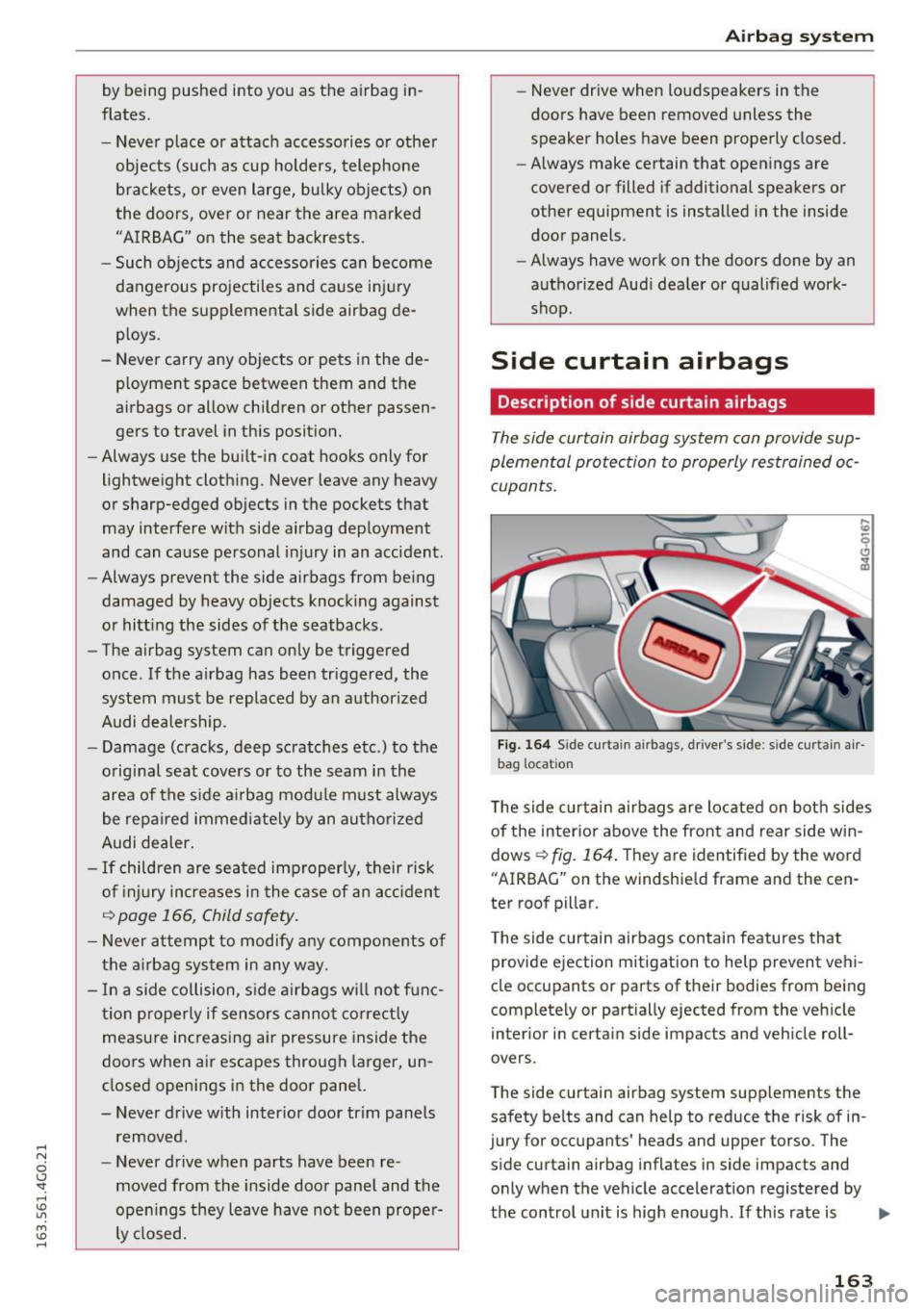
.... N
0 CJ '
by being pushed into you as the airbag in
flates.
- Never place or attach accessories or other objects (such as cup holders, telephone
brackets, or even large, bulky objects) on
the doors, over or near the area marked
"AIRBAG" on the seat backrests.
- Such objects and accessories can become dangerous projectiles and cause injury
when the supplemental side airbag de
ploys.
- Never carry any objects or pets in the de ployment space between them and the
airbags or allow children or other passen
gers to travel in this position.
- Always use the built-in coat hooks only for
lightweight clothing. Never leave any heavy
or sharp-edged objects in the pockets that
may interfere with side airbag deployment
and can cause personal injury in an accident .
- Always prevent the side airbags from being
damaged by heavy objects knocking against
or hitting the sides of the seatbacks.
- The airbag system can only be triggered
once. If the airbag has been triggered, the
system must be replaced by an authorized
Audi dealership .
- Damage (cracks, deep scratches etc.) to the
original seat covers orto the seam in the area of the side airbag module must always
be repaired immediately by an authorized
Audi dealer.
- If children are seated improperly, their risk
of injury increases in the case of an accident
c;, page 166, Child safety.
-Never attempt to modify any components of
the airbag system in any way.
- In a side collision, side airbags will not func
tion properly if sensors cannot correctly
measure increasing air pressure inside the
doors when air escapes through larger, un
closed openings in the door panel.
- Never drive with interior door trim panels removed.
- Never drive when parts have been re
moved from the inside door panel and the
openings they leave have not been proper
ly closed.
Airbag system
-Never drive when loudspeakers in the
doors have been removed unless the
speaker holes have been properly closed.
- Always make certain that openings are
covered or filled if additional speakers or
other equipment is installed in the inside
door panels.
- Always have work on the doors done by an
authorized Audi dealer or qualified work
shop.
Side curtain airbags
Description of side curtain airbags
The side curtain airbag system can provide sup
plemental protection to properly restrained oc cupants.
Fig. 164 S ide curta in airb ags, driver's side: s ide curtai n air
bag locat ion
The side curtain airbags are located on both sides
of the interior above the front and rear side win
dows
c;, fig. 164. They a re identified by the word
"AIRBAG" on the windshield frame and the cen
ter roof pillar .
Th e side curta in airbags contain features that
provide ejection mitigation to help prevent vehi
cle occupants or parts of their bodies from being
completely or partially ejected from the vehicle
interior in certain side impacts and vehicle roll
overs.
The side curtain airbag system supplements the
safety belts and can help to reduce the risk of in
jury for occupants' heads and upper torso . The
side curtain airbag inflates in side impacts and
only when the vehicle acceleration registered by
the control unit is high enough. If this rate is
II>
163
Page 167 of 294
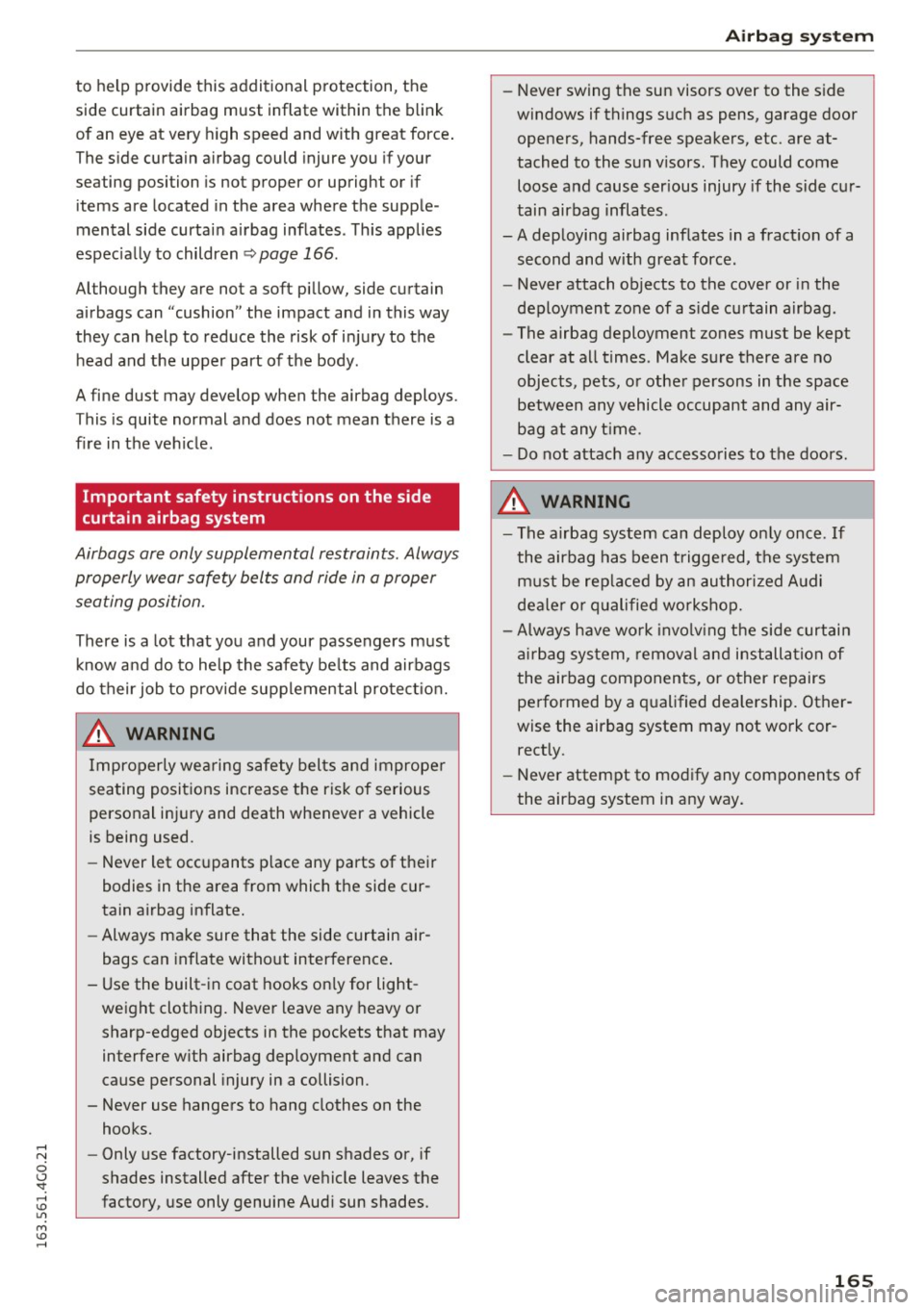
to help provide this additional p rotection, the
side curtain airbag must inflate within the blink
of an eye at very h igh speed and with great force .
The side curtain airbag could injure you if your
seating position is not proper or upright or if
items are located in the area where the supp le
mental side curtain airbag inflates. This applies
espec ia lly to children
~ page 166.
Although they are not a soft pillow, side curtain
airbags can "cushion" the impact and in this way
they can help to reduce the risk of injury to the
head and the upper part of the body.
A fine dust may develop when the airbag deploys.
This is quite normal and does not mean there is a
f ire in the vehicle .
Important safety instructions on the side
curtain airbag system
Airbags are only supplemental restraints. Always
properly wear safety belts and ride in a proper
seating position.
There is a lot that you and your passengers must
know a nd do to help the safety be lts and airbags
do their job to provide supp lemental protec tion .
A WARNING
Improperly wearing safety belts and imprope r
seating positions increase the risk of serious
personal injury and death whenever a vehicle
is being used.
- Never let occupants p lace any parts of their
bodies in the area from which the side cur
tain airbag inflate.
- Always make sure that the side curtain air
bags can inflate without interference .
- Use the built -in coat hooks on ly for light
weight clothing. Never leave any heavy or
sharp-edged objects in the pockets that may interfere w ith airbag deployment and can
cause personal injury in a collision.
- Never use hangers to hang clothes on the
hooks.
- Only use factory-installed sun shades or, if
shades installed after the vehicle leaves the
factory, use only genuine Aud i sun shades.
Airb ag sys tem
-Never swing the sun visors over to the side
windows if things such as pens, garage door
openers, hands-free speakers, etc. are at
tached to the sun v isors. They could come
loose and cause ser ious injury if the side cur
tain airbag inflates.
- A dep loying airbag inflates in a fract ion of a
second and with great force.
- Never attach objects to the cover or in the
deployment zone of a s ide curtain airbag.
- The airbag deployment zones must be kept
clear at all times. Make s ure there are no
objects, pets, o r other persons in the space
between any vehicle occupant and any air
bag at any t ime.
- Do not attach any accesso ries to the doors .
A WARNING
-The airbag sys tem can deploy on ly once. If
the airbag has been trigge red, the system
m ust be rep lace d by an authori zed A udi
dealer or qualified workshop.
- Always have wo rk invo lv ing the side curtai n
airbag system, re moval and i nstallation of
the airbag components, or other repairs
pe rformed by a qualified dealership. Other
wise the airbag system may not work cor
rectly.
- Never attempt to mod ify any components of
the airbag system in any way .
165
Page 168 of 294
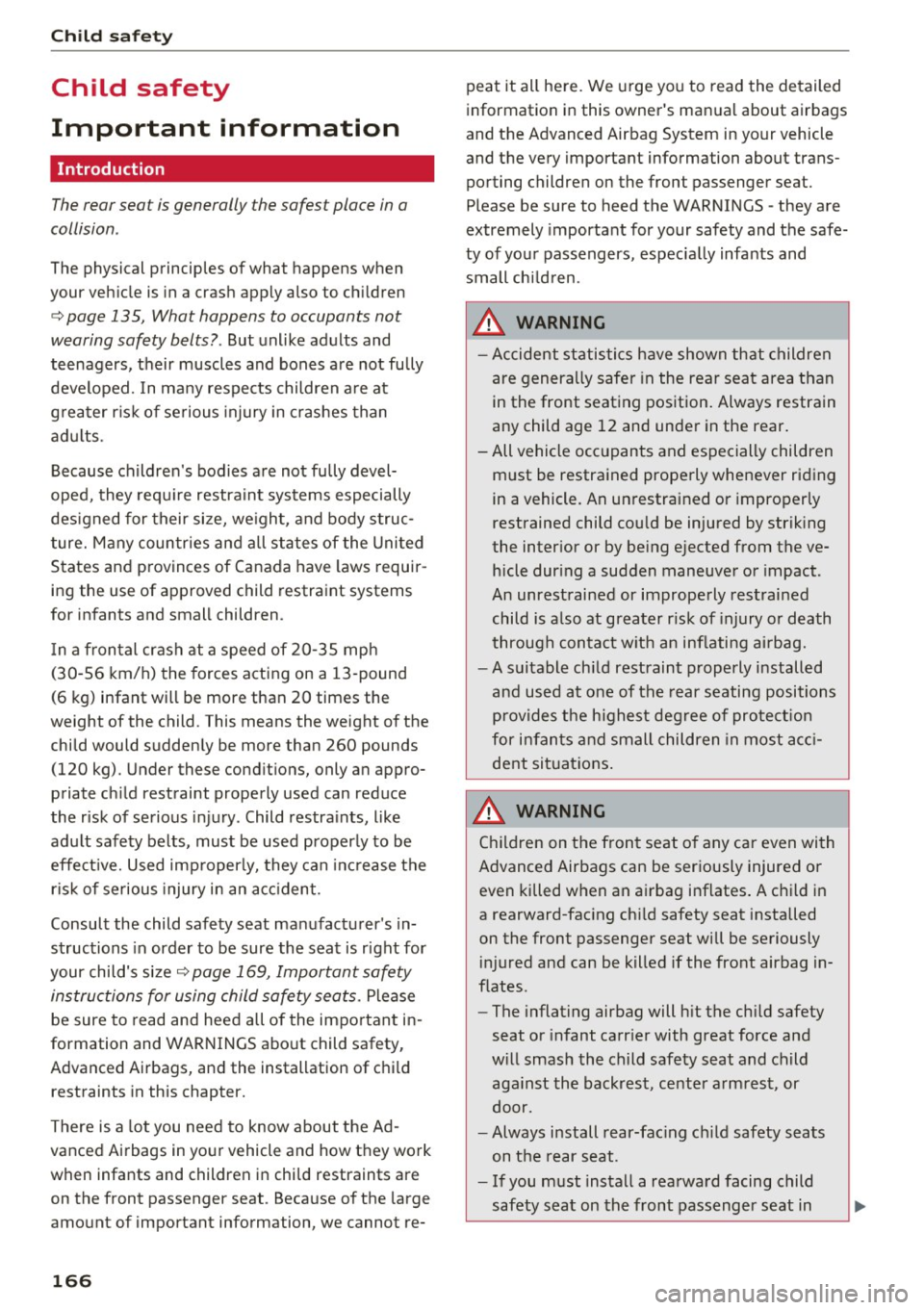
Child safety
Child safety
Important information
Introduction
The rear seat is generally the safest place in a
collision .
The physical principles of what happens when
your vehicle is in a crash apply also to children
¢ page 135, What happens to occupants not
wearing safety belts? .
But unlike adults and
teenagers, their muscles and bones are not fully
developed. In many respects children are at
g reater r isk of serious injury in crashes than
adults .
Because children's bodies are not fully devel
oped, they require restraint systems especially
des igned for their size, weight, and body struc
ture. Many countries and all states of the United
States and provinces of Canada have laws requir
ing the use of approved child restraint systems
for infants and small children .
I n a frontal crash at a speed of 20-35 mph
(30-56 km/h) the forces acting on a 13 -pound
(6 kg) infant will be more than 20 times the
weight of the child. This means the weight of the child would suddenly be more than 260 pounds (120 kg) . Under these conditions, only an appro
priate child restraint properly used can reduce
the risk of serious injury . Child restra ints, like
adu lt safety belts, must be used properly to be
effect ive. Used improperly, they can increase the
risk of serious injury in an acc ident.
Consult the child safety seat manufacturer's in
structions in order to be sure the seat is right for
your child's size¢
page 169, Important safety
instructions for using child safety seats .
Please
be sure to read and heed all of the impo rtant in
formation and WARNINGS about child safety,
Advanced Airbags, and the installation of child
restraints in this chapter.
There is a lot you need to know about the Ad
vanced Airbags in your vehicle and how they work
when infants and children in child restraints are
on the front passenger seat . Because of the large
amount of important information, we cannot re-
166
peat it all here. We urge you to read the detailed
information in this owner's manual about airbags
and the Advanced Airbag System in your vehicle and the very important information about trans
porting children on the front passenger seat.
Please be sure to heed the WARNINGS - they are
extremely importa nt for your safety and the safe
ty of your passengers, especia lly infants and
small chi ldren.
.&_ WARNING
- Accident statistics have shown that children
are generally safer in the rear seat area than
in the front seating position. Always restrain
any child age 12 and under in the rear.
- All vehicle occupants and especially children
must be restrained properly whenever riding
in a vehicle. An unrestrained or improperly
restrained child cou ld be injured by striking
the inter ior or by being ejected from the ve
hicle during a sudden maneuver or impact.
An unrestrained or improperly restrained
child is a lso at greater r isk of injury or death
through contact w ith an inf lating airbag.
- A suitable ch ild restraint properly installed
and used at one of the rear seating positions
provides the highest degree of protect ion
for infants and small children in most acci
dent sit uations.
.&_ WARNING
Children on the front seat of any car even with
Advanced Airbags can be seriously injured or
even killed when an airbag inflates. A child in
a rearward-facing chi ld safety seat installed
on the front passenger seat will be seriously injured and can be killed if the front airbag in
flates.
- The inflating airbag will hit the child safety
seat or infant carr ier with great force and
w ill smash the child safety seat and child
aga inst the backrest , center armrest, or
door.
- Always install rear-facing child safety seats
on the rear seat.
- If you must install a rearward facing child
safety seat on the front passenger seat in
Page 169 of 294
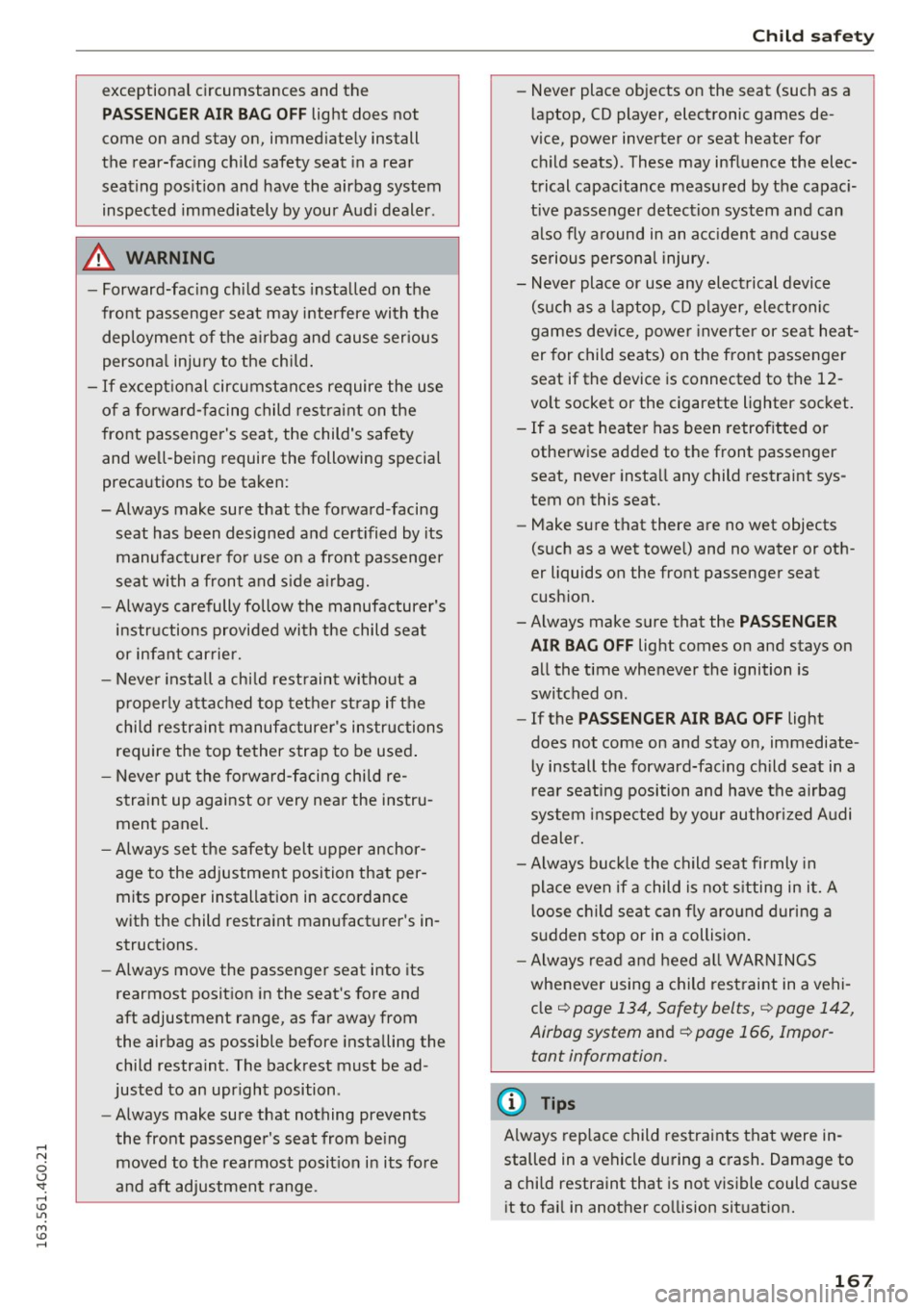
exceptional circumstances and the
PASSENGER AIR BAG OFF light does not
come on and stay on, immediately install
the rear-facing child safety seat in a rear
seating position and have the airbag system
inspected immediately by your Audi dealer .
A WARNING
-Forward-facing child seats installed on the
front passenger seat may interfere with the deployment of the airbag and cause serious
personal injury to the child.
- If exceptional circumstances require the use
of a forward-facing child restraint on the
front passenger's seat , the child's safety
and well-being require the following special
precautions to be taken:
- Always make sure that the forward -facing
seat has been designed and certified by its manufacturer for use on a front passenger
seat with a front and side airbag.
- Always carefully follow the manufacturer's instructions provided with the child seat
or infant carrier.
- Never install a child restraint without a
properly attached top tether strap if the
child restraint manufacturer's instructions
require the top tether strap to be used.
- Never put the forward-facing child re
straint up against or very near the instru
ment panel.
- Always set the safety belt upper anchor
age to the adjustment position that per
mits proper installation in accordance
with the child restraint manufacturer's in
structions.
- Always move the passenger seat into its
rearmost position in the seat's fore and
aft adjustment range, as far away from
the airbag as possible before installing the
child restraint. The backrest must be ad
justed to an upright position .
- Always make sure that nothing prevents
the front passenger's seat from being moved to the rearmost position in its fore
and aft adjustment range .
Child safety
-Never place objects on the seat (such as a
laptop, CD player, electronic games de
vice, power inverter or seat heater for
child seats) . These may influence the elec
trical capacitance measured by the capaci
tive passenger detection system and can
also fly around in an accident and cause serious personal injury.
- Never place or use any electrical device
(such as a laptop, CD player, electronic
games device, power inverter or seat heat
er for child seats) on the front passenger
seat if the device is connected to the 12-
volt socket or the cigarette lighter socket.
- If a seat heater has been retrofitted or
otherwise added to the front passenger
seat, never install any child restraint sys
tem on this seat.
- Make sure that there are no wet objects
(such as a wet towel) and no water or oth
er liquids on the front passenger seat cushion.
- Always make sure that the
PASSENGER
AIR BAG OFF
light comes on and stays on
all the time whenever the ignition is
switched on.
- If the
PASSENGER AIR BAG OFF light
does not come on and stay on, immediate
ly install the forward-facing child seat in a
rear seating position and have the airbag
system inspected by your authorized Audi
dealer.
- Always buckle the child seat firmly in
place even if a child is not sitting in it. A
loose child seat can fly around during a
sudden stop or in a collision.
- Always read and heed all WARNINGS
whenever using a child restraint in a vehi
cle
r=;, page 134, Safety belts, r=;, page 142,
Airbag system
and ¢ page 166, Impor
tant informat ion .
(D Tips
Always replace child restraints that were in
stalled in a vehicle during a crash. Damage to
a child restraint that is not visible could cause it to fail in another collision situation.
167
Page 170 of 294
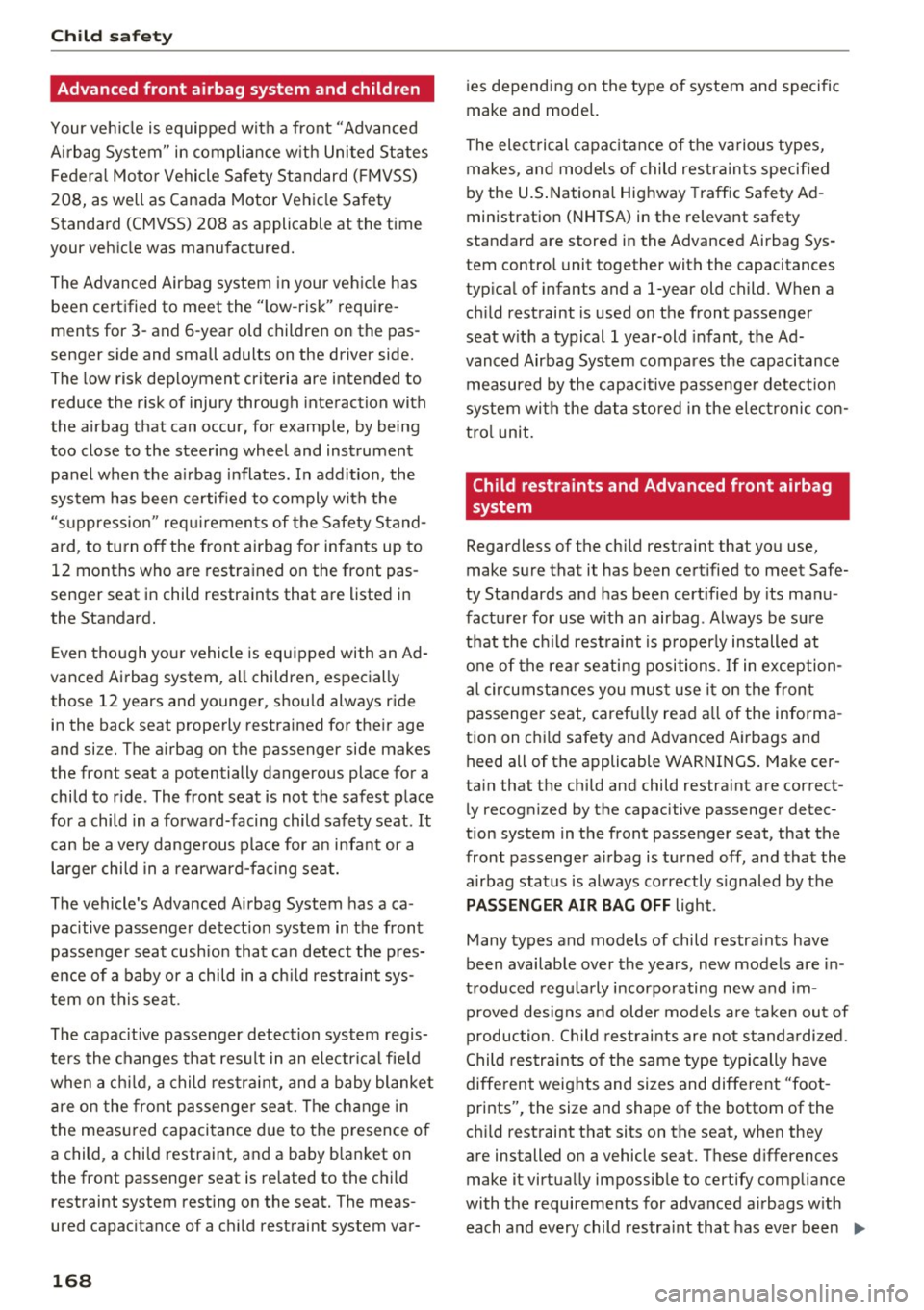
Child safety
Advanced front airbag system and children
Your vehicle is equipped with a front "Advanced
Airbag System" in compliance with United States Federal Motor Vehicle Safety Standard (FMVSS)
208, as well as Canada Motor Vehicle Safety
Standard (CMVSS) 208 as applicable at the time
your vehicle was manufactured.
The Advanced Airbag system in your vehicle has
been certified to meet the "low-risk" require
ments for 3- and 6-year old children on the pas
senger side and small adults on the driver side.
The low risk deployment criteria are intended to
reduce the risk of injury through interaction with
the airbag that can occur, for example, by being
too close to the steering wheel and instrument panel when the a irbag inflates. In addition, the
system has been certified to comply with the
"suppression " requirements of the Safety Stand
ard, to turn off the front airbag for infants up to
12 months who are restrained on the front pas
senger seat in child restraints that are listed in
the Standard.
Even though your vehicle is equipped with an Ad ·
vanced Airbag system, all children, especially
those 12 years and younger, should always ride in the back seat properly restrained for their age
and size. The airbag on the passenger side makes
the front seat a potentially dangerous place for a
child to ride . The front seat is not the safest place
for a child in a forward-facing child safety seat . It
can be a very dangerous place for an infant or a
larger child in a rearward-facing seat.
The vehicle's Advanced Airbag System has a ca
pacitive passenger detection system in the front
passenger seat cushion that can detect the pres
ence of a baby or a child in a child restraint sys
tem on this seat .
The capacit ive passenger detection system regis
ters the changes that result in an electrical field
when a child, a child restraint, and a baby blanket
are on the front passenger seat. The change in
the measured capacitance due to the presence of
a child, a child restraint, and a baby blanket on
the front passenger seat is related to the child restraint system resting on the seat. The meas
ured capacitance of a child restraint system var-
168
ies depending on the type of system and specific
make and model.
The electrical ca pacita nee of the various types,
makes, and models of child restraints specified
by the U.S .National Highway Traffic Safety Ad
ministration (NHTSA) in the relevant safety
standard are stored in the Advanced Airbag Sys
tem control unit together with the capacitances
typical of infants and a 1-year old child. When a
child restraint is used on the front passenger
seat w ith a typical 1 year-old infant, the Ad
vanced Airbag System compares the capacitance measured by the capacitive passenger detection
system with the data stored in the electronic con
trol unit.
Child restraints and Advanced front airbag
system
Regardless of the child restraint that you use,
make sure that it has been certified to meet Safe
ty Standards and has been certified by its manu
facturer for use with an airbag . Always be sure
that the child restraint is properly installed at
one of the rear seating positions. If in exception
al circumstances you must use it on the front
passenger seat, carefully read all of the informa
tion on child safety and Advanced Airbags and heed all of the applicable WARNINGS. Make cer
tain that the child and child restraint are correct ly recognized by the capacitive passenger detec
tion system in the front passenger seat, that the
front passenger airbag is turned off, and that the airbag status is always correctly signaled by the
PASSENGER AIR BAG OFF light .
Many types and models of child restraints have
been available over the years, new models are in
troduced regularly incorporating new and im
proved designs and older models are taken out of
production. Child restraints are not standardized.
Child restraints of the same type typically have
different weights and sizes and different "foot
prints", the size and shape of the bottom of the
child restraint that sits on the seat, when they
are installed on a vehicle seat. These differences make it virtually impossible to certify compliance
with the requirements for advanced airbags with
each and every child restraint that has ever been .,..
Page 172 of 294

Child safety
to prevent the child safety seat from moving
¢page 176.
~ Push the child safety seat down with your full
weight to get the safety belt really tight so that
the seat cannot move forward or sideways
more than one inch (2.5 cm) .
~ Secure unused safety belts on the rear seat
¢page 171 .
Always remember: Even though your vehicle is
equipped with an Advanced Airbag system, all
children, especially those 12 years and younger,
should always ride in the back seat properly re
strained for their age and size.
_& WARNING
Not using a child safety seat, using the wrong
child safety seat or improperly installing a
child restraint increases the risk of serious
personal injury and death.
-All vehicle occupants and especially children
must be restrained properly whenever riding
in a vehicle. An unrestrained or improperly
restrained child could be injured by striking
the interior or by being ejected from the ve
hicle during a sudden maneuver or impact.
An unrestrained or improperly restrained
child is also at greater risk of injury or death
through contact with an inflating airbag .
- Commercially available child safety seats
are required to comply with U .S. Federal
Motor Vehicle Safety Standard (FMVSS) 213
(in Canada CMVSS 213).
- When buying a child restraint, select one
that fits your child and the vehicle.
- Only use child restraint systems that fully
contact the flat portion of the seat cush
ion. The child restraint must not tip or
lean to either side. Audi does not recom
mend using child safety seats that rest on
legs or tube-like frames. They do not pro
vide adequate contact with the seat.
-Always heed all legal requirements per
taining to the installation and use of child
safety seats and carefully follow the in
structions provided by the manufacturer
of the seat you are using.
170
-Never allow children under 57 inches
(1.45 meters) to wear a normal safety belt.
They must always be restrained by a proper child restraint system . Otherwise, they
could sustain injuries to the abdomen and
neck areas during sudden braking maneu
vers or accidents .
- Never let more than one child occupy a child
safety seat.
- Never let babies or older children ride in a
vehicle while sitting on the lap of another passenger.
- Holding a child in your arms is never a sub
stitute for a child restraint system.
- The strongest person could not hold the
child with the forces that exist in an acci
dent. The child will strike the interior of
the vehicle and can also be struck by the
passenger.
- The child and the passenger can also in jure each other in an accident.
- Never install rear-facing child safety seats
or infant carriers on the front passenger
seat. A child will be seriously injured and
can be killed when the passenger airbag in
flates -even with an Advanced Airbag Sys
tem.
- The inflating airbag will hit the child safety
seat or infant carrier with great force and
will smash the child safety seat and child
against the backrest, center armrest door
,
or roof.
- Always install rear-facing child safety seats
or infant carriers on the rear seat.
- Forward-facing child safety seats installed
on the front passenger's seat can interfere
with the airbag when it inflates and cause
serious injury to the child. Always install for
ward-facing child safety seats on the rear
seat .
- If exceptional circumstances require the use
of a forward-facing child restraint on the
front passenger's seat, the child's safety
and well-being require that the following
special precautions be taken: .._
.__ ______________ _j ...